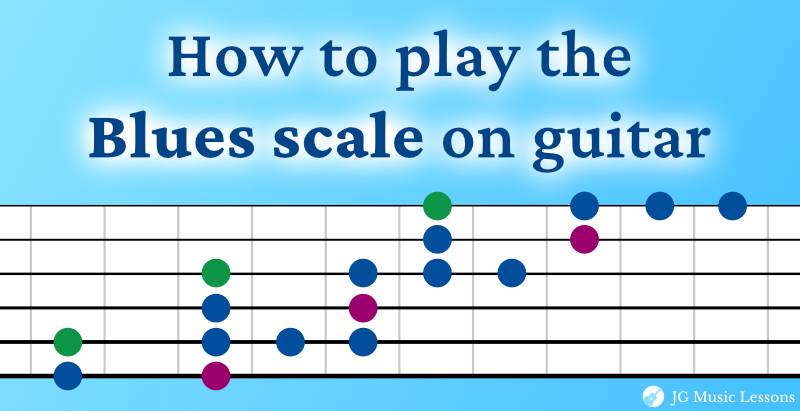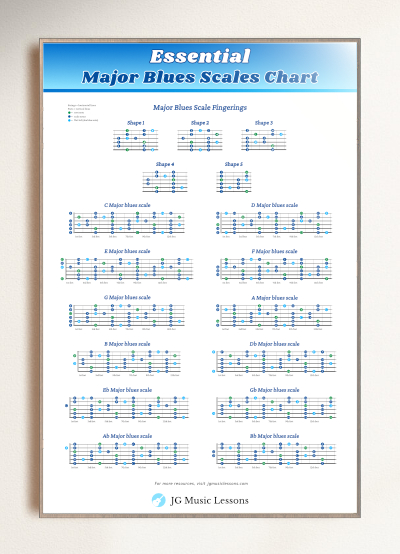The blues scale is one of the most essential guitar scales to learn, as it works across a variety of genres, including rock, blues, jazz, and pop. Its distinctive, expressive sound makes it a go-to tool for improvisation which helps your playing stand out.
Mastering this scale opens up a world of creative possibilities, making improvisation more exciting and natural over chord progressions and songs. In this lesson, we’ll break down the music theory behind the blues scale, show you how to play it in different keys, explore the five scale shapes across the fretboard, and introduce patterns you can use to spark your own improvisations.
Grab your guitar and let’s dive in!
* Free for Pro Members
Blues scale formula
The blues scale is a set of 6 notes based on the pentatonic scale with an added chromatic note. This extra chromatic note, sometimes referred to as the blue note, gives the scale its distinctive sound.
It’s important to note that there are two types of blues scales: the Major blues scale, and the minor blues scale. Let’s look at their formulas one by one.
Major scale blues formula
The Major blues scale has the scale degrees 1, 2, b3, 3, 5, and 6. For example, a C Major blues scale has the notes C, D, Eb, E, G, and A. The Major blues scale is essentially a Major pentatonic scale with an added half step between the 2nd and 3rd scale degrees (see the formula below).

You can learn the C Major pentatonic here if you don’t know it already.
Minor scale blues formula
The minor blues scale has the scale degrees, 1, b3, 4, #4, 5, and b7. For example, the A minor blues scale has the notes A, C, D, D#, E, and G. The minor blues scale is essentially a minor pentatonic scale with an added half step between the 4th and 5th scale degrees (see the formula below).

Major blues scales examples
Now we’ll apply the Major blues scale formula starting on different root notes. Each scale below will cover two octaves on the guitar in standard notation with tabs and audio examples included.
Even though these blues scale examples are written 4/4 time, you can apply the notes to any time signature.
C Major blues scale
The C Major blues scale has the notes C, D, Eb, E, G, and A. The small numbers on top of the notes represent the suggested fingerings for your fretting hand.

A Major blues scale
The A Major blues scale has the notes A, B, C, C#, E, and F#.

Major blues scales chart
Here is a chart of all the Major blues scales starting on every root note.
| Major blues scale | 1 | 2 | b3 | 3 | 5 | 6 |
|---|---|---|---|---|---|---|
| C Major blues scale | C | D | Eb | E | G | A |
| D Major blues scale | D | E | F | F# | A | B |
| E Major blues scale | E | F# | G | G# | B | C# |
| F Major blues scale | F | G | Ab | A | C | D |
| G Major blues scale | G | A | Bb | B | D | E |
| A Major blues scale | A | B | C | C# | E | F# |
| B Major blues scale | B | C# | D | D# | F# | G# |
| Db Major blues scale | Db | Eb | E | F | Ab | Bb |
| Eb Major blues scale | Eb | F | Gb | G | Bb | C |
| Gb Major blues scale | Gb | Ab | B | Bb | Db | Eb |
| Ab Major blues scale | Ab | Bb | B | C | Eb | F |
| Bb Major blues scale | Bb | C | Db | D | F | G |
Minor blues scales examples
A minor blues scale
Did you know that the A minor blues scale has the exact same notes as the C Major blues scale? The only difference is that you are starting on the 6th degree.
Here is an A minor blues scale which has the notes A, C, D, D#, E, and G.

If you know your Major scale shapes, you will see how the relative minor scale includes the same notes.
C minor blues scale
The C minor blues scale has the notes C, Eb, F, F#, G, and Bb.

E minor blues scale
The E minor blues scale has the notes E, G, A, A#, B, and D.

Minor blues scales chart
Here is a chart of all the minor blues scales starting on every root note.
| Minor blues scale | 1 | b3 | 4 | #4 | 5 | b7 |
|---|---|---|---|---|---|---|
| C minor blues scale | C | Eb | F | F# | G | Bb |
| D minor blues scale | D | F | G | G# | A | C |
| E minor blues scale | E | G | A | A# | B | D |
| F minor blues scale | F | Ab | Bb | B | C | Eb |
| G minor blues scale | G | Bb | C | C# | D | F |
| A minor blues scale | A | C | D | D# | E | G |
| B minor blues scale | B | D | E | F | F# | A |
| Db minor blues scale | Db | E | Gb | G | Ab | B |
| Eb minor blues scale | Eb | Gb | Ab | A | Bb | Db |
| Gb minor blues scale | Gb | A | B | C | Db | E |
| Ab minor blues scale | Ab | B | Db | D | Eb | Gb |
| Bb minor blues scale | Bb | Db | Eb | E | F | Ab |
Now that you have a better understanding of the music theory behind the Major and minor blues scales, let’s start learning the scale shapes throughout the fretboard.
* Free for Pro Members
5 Blues scale shapes on guitar
We can break down the blues scale into 5 different sections of the guitar fretboard. You can play these shapes starting on any root note.
How to read the scale charts
For the charts below:
- Lowest horizontal line represents the thickest string (Low E) and the top horizontal line represents the thinnest string (high E).
- The green circles represent the root note of the Major blues scale.
- Purple notes represent the root note of the minor blues scale.
- Blue is every other note in between.
- Light blues indicates the “blue note”.
- The numbers inside the circles represent the suggested fingering to use on your fretting hand.
(Remember that the Major and minor blues share the same notes by starting on different scale degrees.)
If needed, check out how to read guitar notation symbols.

Blues scale shape 1
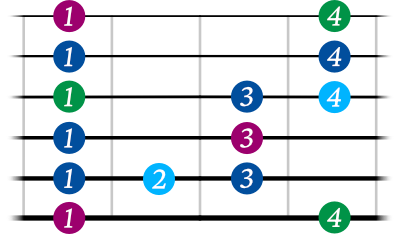
Blues scale shape 2
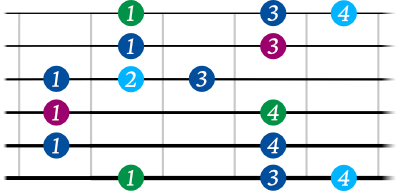
Blues scale shape 3

Blues scale shape 4
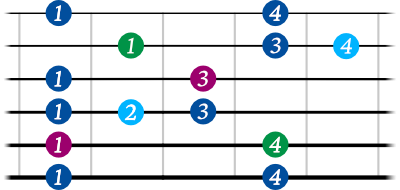
Blues scale shape 5
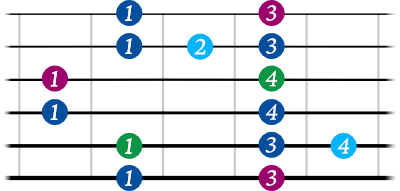
One thing to note about using these shapes is that whenever you have scales where you can use open strings, you will have to rearrange your fingers to play the shape. For example, if a shape includes the fingering 1, 3, and 4 on one string, you can play (open string), 1 and 3 instead.
Although you will need to change some shapes if you include open strings, once you move over to the next shape where you’re fretting all the notes, you will get back to the original shapes we covered here.
Blues scale guitar patterns
A way to practice blues scales is to learn scale patterns for creative application in your playing. Use the following blues scale patterns as a guide for you to use over a chord or chord progression. You can create your own scale patterns based on these examples. I also recommend trying these patterns in different keys to truly master them on the guitar.
The following 6 note and 8 note patterns are all based in the key of C Major or A minor.
6 note ascending blues scale pattern
For this 6 note pattern, I’m playing the 6 notes of the blues scale starting from the lowest string and then starting the consecutive pattern again on the next string (6th, 5th, 4th, then 3rd string). I start each pattern on the 1st note of the scale shape rather than thinking about what degree comes next.
Check out the example to show you what I mean.

6 note descending blues scale pattern
This is the same concept as the last example, except you move down the blues scale in a 6 consecutive note pattern.

8 note ascending blues scale pattern
For this pattern, we’re playing the 8 notes of the blues scale starting from the lowest string and then starting the consecutive pattern again on the next string.

8 note descending blues scale pattern
This is the same concept as the last example, except you move down the blues scale in an 8 note consecutive pattern.

Ascending blues scale – 3 octaves
For this pattern, we are playing the blues scale in 3 octaves to show you how to connect the notes on the fretboard.
The next two examples can apply to the key of E Major or C# minor.

Descending blues scale – 3 octaves
This pattern is the same as the previous example but moving down the notes of the scale in 3 octaves.

For more ideas to incorporate the blues scale in improvisation, check out these 7 jazz and blues licks over a dominant 7 chord.
3 tips for memorizing the blues scale shapes
Here are 3 quick tips to help you memorize the 5 blues scale shapes.
1. Master one shape at a time
The way I recommend learning and memorizing any scale is to start with one shape that feels most comfortable for you. Try to really get the shape under your fingers to the point where you don’t have to look at the chart. Use the first shape you master as a guide to learn the other scale shapes around it.
2. Look for repeating fingering patterns
You want to look for patterns such as what strings repeat the same fingering within a shape.
Quick tip: The notes on the first and sixth string will always be the same.
For example, in shape 1 we see that the 1st, 2nd, and 6th string follow a 1 and 4 finger pattern.
Knowing where fingering patterns repeat will help you build a mental map of a scale shape.
3. Connect shapes around the ones you learned
After learning one of the scale shapes well, either learn the shape that comes before or after it to see how the notes connect on the fretboard. Again, try to master one shape at a time and make sure you can play it without looking at the chart.
This will make the process more approachable by breaking it down into smaller sections before moving on to the next shape.
Wrapping up
In this lesson, we covered the difference between the Major and minor blues scales. They are both 6 note scales which include a chromatic note, also referred to as the blue note.
We looked at how to play these blues scales in different keys, learned the scale shapes throughout the fretboard, and learned different patterns that you can use for improvisation.
Playing the blues can also refer to a song form known as a 12 bar blues. To learn more, you can check out how to play the blues on guitar or how to play a minor blues progression.
You may also want to learn how make your melody lines sound jazzy.
📘 Get the free guitar practice guide here!
All the best,
JG Music Lessons
📙 Kickstart your guitar playing with our step by step guide: Guitar Essentials.
🎸 Looking for a travel or half-sized guitar? See this one.
🛠 See our other music recommendations.
🤝 Support the site to help us to create better content for you!
Level up with the FREE guitar practice guide and effectively improve your playing! 🎸
Get it sent to your email!

